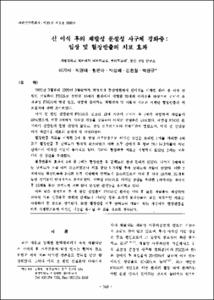KUMEL Repository
1. Journal Papers (연구논문)
1. School of Medicine (의과대학)
Dept. of Internal Medicine (내과학)
신 이식 후의 재발성 분절성 사구체 경화증 : 임상 및 혈장반출의 치료 효과
- Keimyung Author(s)
- Hwang, Eun Ah; Park, Sung Bae; Kim, Hyun Chul; Park, Kwan Kyu
- Journal Title
- 대한신장학회지
- Issued Date
- 2000
- Volume
- 19
- Issue
- 5
- Abstract
- The recurrence of focal segmental glomeruloscle-rosis(FSGS) after renal transplantation has a potentially deteriorating course toward the loss of graft function. To identify risk factors for recurrence and efficacy of plasmapheresis, we evaluated outcome of 20 renal allografts in 18 patients with FSGS who underwent transplantation from March 1992 to September 1999.
Recurrence was observed in seven of 18(39%) patients. Patients who had rapid progression to end stage renal disease, young age at the time of onset of the disease and the presence of mesangial proliferation tended to more frequent recurrence, albeit statistically not significant.
Five patients underwent plasmapheresis. Proteinuria decreased from 5.3±2,lg to 0.8±0,7g immediately after completion of plasmapheresis. Four patients with an improvement in proteinuria had stable renal function at last follow-up.
One patient who had chronic rejection lost graft function at 22 months after renal transplantation. In one in whom plasmapheresis was initiated immediately without allograft biopsy had long-lasting complete remission. Two patients who not receive plasma-Apheresis, lost their graft funtion at 21 and 97 months after renal transplantation.
We concluded that plasmapheresis in likely to be effective in the therapy of recurrent FSGS if the diagnosis is made promptly following the appearance of proteinuria, there is no significant hyalinosis on pre-plasmapheresis biopy and plasmapheresis is initiated immediately.
1992년 3월부터 1999년 9월말까지 계명의대 동산병원에서 신이식을 시행한 환자 중 이식 전 원인 신질환이 FSGS로 진단된 18예의 환자에서 시행된 20예의 이식신을 대상으로 신이식 후 재발성 FSGS의 발생 빈도, 재발에 관여하는 위험인자 및 이들의 치료로 시행한 혈장반출의 치료효과에 대해 조사하였다.
이식 전 원인 신질환이 FSGS로 진단된 18예 가운데 신이식 후 7예가 재발하여 재발율이 39%였으며,이중 3예에서 이식신 기능올 상실하여 이식신 상실율은 43%였다. 재발성 FSGS 환 자에서 신질환의 발병 연령이 젊었고, 만성 신부전으로의 진행기간이 빨랐으며, 이식 전 신생검 에서 메산지움 세포의 중식이 더 저명하였다.
혈장반출 치료를 시행한 5예 중 만성 거부반옹으로 이식신 상실을 초래한 1예를 제외한 4예 모두 혈장반출 후 단백뇨가 현저히 감소하였고 이들 모두 신이식 후 평균 26±14.3개월이 지난 현재까지 이식신 기능이 유지되고 있다. 그러나 혈장반출 치료를 시행하지 않았던 2예는 모두 이식 신 상실을 초래했다.
혈장반출의 효과로 4예 중 1예는 혈장반출 후 단백뇨의 완전 관해가 있었다. 나머지 3예에서 는 단백뇨가 소실 내지 감소되었으나 치료 중단 1-3개월 후에 단백뇨의 재발이 있었다. 이중 2 예에서는 혈장반출올 3-5회 반복 시행하여 단백뇨가 감소되었으며 이식 후 각각 18개월, 32개월 동안 신기능이 안정적으로 유지되었다. 재발성 FSGS로 이식신 상실을 초래한 1예에서는 재이식 후 15개월 동안 단백뇨의 재발 없이 안정된 신기능을 유지하고 있다.
이와 같은 성적으로 볼 때 원인 신질환이 FSGS인 환자는 이식 후 높은 재발율이 예상되며 신이식 직후 신증후군 범위의 단백뇨가 나타날 경우 조기에 혈장반출과 같은 적극적인 치료를 시행해야 할 것으로 생각된다. 또한 혈장반출 이후 단백뇨의 재발이 있는 경우에도 혈장반출올 반복 시행함으로써 이식신 기능을 유지할 수 있을 것으로 생각된다.
- Alternative Title
- Recurrent Focal Segmental Glomerulosclerosis Following Renal Transplantation: Natural Course and Treatment with Plasmapheresis
- Publisher
- School of Medicine
- Citation
- 이기태 et al. (2000). 신 이식 후의 재발성 분절성 사구체 경화증 : 임상 및 혈장반출의 치료 효과. 대한신장학회지, 19(5), 918–925.
- Type
- Article
- ISSN
- 1225-0015
- 파일 목록
-
-
Download
 oak-bbb-02440.pdf
기타 데이터 / 488.24 kB / Adobe PDF
oak-bbb-02440.pdf
기타 데이터 / 488.24 kB / Adobe PDF
-
Items in Repository are protected by copyright, with all rights reserved, unless otherwise indicated.